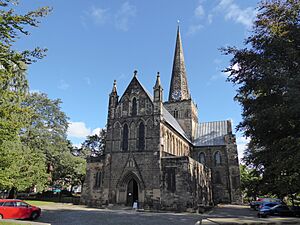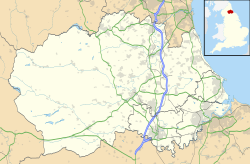St Cuthbert's Church, Darlington facts for kids
Quick facts for kids St Cuthbert’s Church, Darlington |
|
|---|---|

St Cuthbert's Church, Darlington
|
|
| 54°31′27″N 1°33′4.8″W / 54.52417°N 1.551333°W | |
| OS grid reference | NZ 29106 14442 |
| Location | Darlington |
| Country | England |
| Denomination | Church of England |
| History | |
| Dedication | Cuthbert of Lindisfarne |
| Architecture | |
| Heritage designation | Grade I listed |
| Specifications | |
| Length | 130 feet (40 m) |
| Width | 75 feet (23 m) |
| Nave width | 44 feet (13 m) |
| Spire height | 180 feet (55 m) |
| Administration | |
| Parish | Darlington St Cuthbert |
| Deanery | Darlington |
| Archdeaconry | Auckland |
| Diocese | Durham |
St Cuthbert's Church in Darlington, County Durham, is a historic church. It belongs to the Church of England and is part of the Diocese of Durham.
Contents
Exploring the Church's Past
This church has a long history, starting in the early 1100s. In 1439, it became a "collegiate" church. This meant it had a special group of clergy, led by a Dean. Richard Whitton was the first Dean. This system lasted until 1550 when it was ended.
Major Changes and Repairs
On July 17, 1750, lightning struck the church's spire. Because of this, the central tower had to be rebuilt in 1752.
A big restoration project happened between 1864 and 1865. Architects George Gilbert Scott and James Pigott Pritchett led the work. The repairs cost about £1,590. A generous donation of £500 came from William Vane, the 3rd Duke of Cleveland.
During this restoration, old galleries and ceilings were removed. Windows in the nave and transepts were opened up. The seating was rearranged, and some old stalls were replaced. The most important work was done in the chancel. Here, old features like the piscina and armoury were fixed. The floor was relaid with colorful tiles. Eleven new stained glass windows were also added.
New items were given to the church. R.H. Allan donated a font made of grey polished marble. Miss Topham gave a lectern. The church's organ was repaired, and the bells in the tower were recast. The church reopened for services on December 14, 1865.
Church Leaders Through the Years
The church has had many leaders over the centuries. They are called Vicars or Deans.
Vicars from 1309 to 1436
- Robert de Royeston (1309)
- Richard de Hadyngton (1344)
- William de Welton (1354)
- Robert de Hunmandby (1361)
- William Hoton (1398)
- William Hesel (1411)
- Stephen Austell (1416)
- Richard Wytton (1428)
- Richard Bicheburn (1436)
- Richard Witton
Deans from 1439 to 1550
- Richard Witton (1439)
- Roland Hardgyll (1451)
- Robert Symson (1466)
- Ralph Lepton (1497)
- Cuthbert Marshall (around 1548)
Vicars from 1550 Onwards
- Sir John Claxton (1561)
- James Thornton (1571)
- John Welshe (1571)
- John Woodfall (1584)
- Robert Gesford (1601)
- Robert Tomlinson (1602)
- Isaac Lowden (1606)
- Bryan Grant (1612)
- Robert Hope (1622)
- Thomas Clapperton (1640)
- William Parish
- George Bell (1661)
- George Thompson (1693)
- John Hall (1712)
- Cornelius Harrison (1727)
- Andrew Wood (1748)
- Henry Hemington (1772)
- William Gordon (1784)
- John William Drage Merest (1831 - 1846)
- A.J. Howell (1846 - 1860)
- John Garencieres Pearson (1860 - 1873)
- Canon Hodgson (1873 - 1894)
- Francis Warren Mortimer (1894 - 1905)
- David Walker (1906 - 1919)
- Robert Ferry Drury (1919 - 1935)
- William C. Jordan (1935 - 1943)
- David Brownfield Porter (1943 - 1947)
- George Holderness (1947 - 1954)
- Peter Wansey (1955 - 1974)
- John David Treadgold (1974 - 1981)
- Canon Leslie Gready (???? - 1993)
- Geoff Miller (1996 - 1999)
- Robert John Williamson (2000 - 2016)
- Matthew Paul Firth (2018 - 2020)
- James Harvey (2021 - present)
The Church Organ
The church's organ was built in 1880 by Forster and Andrews. It has been worked on by other companies since then. Today, it has 38 stops and three manuals, plus pedals. This means it can make many different sounds. The new organ cost about £1,000 when it was installed. It was first played on November 3, 1880, by William Thomas Best.
Organists of St Cuthbert's
- George J. Crossley (around 1830s - 1850)
- Frederick Second (1850 - 1858)
- J.W. Marshall (1858 - 1896)
- Dr. Thomas Hutchinson (1896 - 1917)
- Arthur Kitson (1917 - 1941)
- Edgar Miller (1941 - ????)
- Hector C. Parr
- Paul Busby (2005 - 2012)
- David Ratnanayagam
Church Bells
The tower of St Cuthbert's Church holds a set of 8 bells. These bells were made by Gillett & Johnston in 1937.


